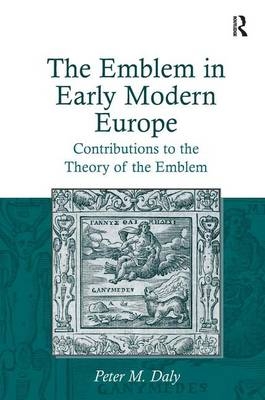
The Emblem in Early Modern Europe
Contributions to the Theory of the Emblem
Seiten
2014
Routledge (Verlag)
978-1-4724-3013-7 (ISBN)
Routledge (Verlag)
978-1-4724-3013-7 (ISBN)
The emblem was big business in early-modern Europe, used extensively not only in printed books and broadsheets, but also to decorate pottery, metalware, furniture, glass and windows and numerous other domestic, devotional and political objects. At its most basic level simply a combination of symbolic visual image and texts.
The emblem was big business in early-modern Europe, used extensively not only in printed books and broadsheets, but also to decorate pottery, metalware, furniture, glass and windows and numerous other domestic, devotional and political objects. At its most basic level simply a combination of symbolic visual image and texts, an emblem is a hybrid composed of words and picture. However, as this book demonstrates, understanding the precise and often multiple meaning, intention and message emblems conveyed can prove a remarkably slippery process. In this book, Peter Daly draws upon many years’ research to reflect upon the recent upsurge in scholarly interest in, and rediscovery of, emblems following years of relative neglect. Beginning by considering some of the seldom asked, but important, questions that the study of emblems raises, including the importance of the emblem, the truth value of emblems, and the transmission of knowledge through emblems, the book then moves on to investigate more closely-focussed aspects such as the role of mnemonics, mottoes and visual rhetoric. The volume concludes with a review of some perhaps inadequately considered issues such as the role of Jesuits (who had a role in the publication of about a quarter of all known emblem books), and questions such as how these hybrid constructs were actually read and interpreted. Drawing upon a database containing records of 6,514 books of emblems and imprese, this study suggests new ways for scholars to approach important questions that have not yet been satisfactorily broached in the standard works on emblems.
The emblem was big business in early-modern Europe, used extensively not only in printed books and broadsheets, but also to decorate pottery, metalware, furniture, glass and windows and numerous other domestic, devotional and political objects. At its most basic level simply a combination of symbolic visual image and texts, an emblem is a hybrid composed of words and picture. However, as this book demonstrates, understanding the precise and often multiple meaning, intention and message emblems conveyed can prove a remarkably slippery process. In this book, Peter Daly draws upon many years’ research to reflect upon the recent upsurge in scholarly interest in, and rediscovery of, emblems following years of relative neglect. Beginning by considering some of the seldom asked, but important, questions that the study of emblems raises, including the importance of the emblem, the truth value of emblems, and the transmission of knowledge through emblems, the book then moves on to investigate more closely-focussed aspects such as the role of mnemonics, mottoes and visual rhetoric. The volume concludes with a review of some perhaps inadequately considered issues such as the role of Jesuits (who had a role in the publication of about a quarter of all known emblem books), and questions such as how these hybrid constructs were actually read and interpreted. Drawing upon a database containing records of 6,514 books of emblems and imprese, this study suggests new ways for scholars to approach important questions that have not yet been satisfactorily broached in the standard works on emblems.
Peter M. Daly has degrees from universities in Bristol and Zurich and spent most of his university career in Canada. His research and publications have been largely on emblems and German baroque literature.
Contents: Preface; Introduction; Recent emblem theory; The importance of emblems; Truth in emblems; Emblems as transmitters of knowledge and traditions; Mnemonics and emblems; Are emblem inscriptiones always mottoes?; Is there visual rhetoric in some emblem pictures?; How were and how are emblems read?; On the interpretation of emblems; Jesuit emblems: in the service of God, man or the Society of Jesus?; Selective bibliography; Index.
| Erscheint lt. Verlag | 28.6.2014 |
|---|---|
| Verlagsort | London |
| Sprache | englisch |
| Maße | 156 x 234 mm |
| Gewicht | 589 g |
| Themenwelt | Kunst / Musik / Theater ► Kunstgeschichte / Kunststile |
| Geschichte ► Allgemeine Geschichte ► Neuzeit (bis 1918) | |
| Geisteswissenschaften ► Geschichte ► Regional- / Ländergeschichte | |
| Geisteswissenschaften ► Sprach- / Literaturwissenschaft ► Anglistik / Amerikanistik | |
| Geisteswissenschaften ► Sprach- / Literaturwissenschaft ► Literaturwissenschaft | |
| ISBN-10 | 1-4724-3013-1 / 1472430131 |
| ISBN-13 | 978-1-4724-3013-7 / 9781472430137 |
| Zustand | Neuware |
| Haben Sie eine Frage zum Produkt? |
Mehr entdecken
aus dem Bereich
aus dem Bereich
Europa 1848/49 und der Kampf für eine neue Welt
Buch | Hardcover (2023)
DVA (Verlag)
48,00 €
Giordano Bruno - ein ketzerisches Leben
Buch | Hardcover (2024)
C.H.Beck (Verlag)
29,90 €


